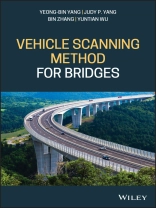Presents the first ever guide for vehicle scanning of the dynamic properties of bridges
Written by the leading author on the subject of vehicle scanning method (VSM) for bridges, this book allows engineers to monitor every bridge of concern on a regular and routine basis, for the purpose of maintenance and damage detection. It includes a review of the existing literature on the topic and presents the basic concept of extracting bridge frequencies from a moving test vehicle fitted with vibration sensors. How road surface roughness affects the vehicle scanning method is considered and a finite element simulation is conducted to demonstrate how surface roughness affects the vehicle response. Case studies and experimental results are also included.
Vehicle Scanning Method for Bridges covers an enhanced technique for extracting higher bridge frequencies. It examines the effect of road roughness on extraction of bridge frequencies, and looks at a dual vehicle technique for suppressing the effect of road roughness. A filtering technique for eliminating the effect of road roughness is also presented. In addition, the book covers the identification of bridge mode shapes, contact-point response for modal identification of bridges, and damage detection of bridges–all through the use of a moving test vehicle.
* The first book on vehicle scanning of the dynamic properties of bridges
* Written by the leading author on the subject
* Includes a state-of-the-art review of the existing works on the vehicle scanning method (VSM)
* Presents the basic concepts for extracting bridge frequencies from a moving test vehicle fitted with vibration sensors
* Includes case studies and experimental results
The first book to fully cover scanning the dynamic properties of bridges with a vehicle, Vehicle Scanning Method for Bridges is an excellent resource for researchers and engineers working in civil engineering, including bridge engineering and structural health monitoring.
About the author
YEONG-BIN YANG, PHD, is Honorary Dean of Civil Engineering, Chongqing University in China, Feng Tay Chair Professor of National Yunlin University of Science and Technology (Yun Tech), and Professor Emeritus of National Taiwan University (NTU) in Taiwan. He is a member of the Chinese Academy of Engineering, Austrian Academy of Sciences, and EU Academy of Sciences. Also, he is an Editor-in-Chief of the International Journal of Structural Stability and Dynamics, President of the Asian-Pacific Association of Computational Mechanics (APACM), and Chairman of the East Asia-Pacific Conference on Structural Engineering and Construction (EASEC).
JUDY P. YANG, PHD, is an Associate Professor in the Dept. of Civil Engineering, National Chiao Tung University, Taiwan.
BIN ZHANG is a Ph D student in the School of Civil Engineering, Chongqing University in China.
YUNTIAN WU, PHD, is a Professor in the School of Civil Engineering, Chongqing University, China.












